Environmental Pollution Analysis and Impact Study—A Case Study for the Salton Sea in California
Abstract
:1. Introduction
2. Related Work
2.1. Literature Survey
2.2. Technology Survey
3. Data Engineering
3.1. Data Collection
3.2. Data Preprocessing
- Step 1: For the AQDQT and MDQT data, we used the following steps to preprocess the raw data of the air pollutants and meteorological data.
- Merge year-wise files for each pollutant and weather into one;
- Remove descriptive variables like name, units, quality, prelim, met source, and site name from the dataset;
- Represent each pollutant and weather data by using a unique column for a given date and hour;
- Use pandas backfill and forward fill to impute null values;
- Create line plots, box plots and statistical correlation plots to make outlier and anomaly detection.
- Step 2: For MODIS data, we used the following steps to preprocess the raw data of NDVI.
- Reproject MODIS data to Universal Transverse Mercator (UTM)-European Petroleum Survey Group (EPSG): 32611;
- Extract NDVI values using latitude and longitude of the location of monitor stations;
- Merge all the data into one file;
- Drop outliers, obtain dummy variables and do a normalization.
- Step 3: For Landsat 8 satellite images, we used the following steps to preprocess the raw data of the distance to the Salton Sea.
- Generates open water cover mask for Landsat 8 using water detect [44];
- Obtain the shapefile of the Salton Sea area.
- Step 4: For the asthma data, we used the following steps to preprocess the raw data.
- Collect the asthma data for Salton Sea counties, zip code and stratified at age group;
- Map zip codes to monitoring sites to merge year-wise air-quality pollutants, weather and surface area data;
- Perform data cleaning on each dataset separately using pandas and NumPy;
- Impute the missing values with group mean (year, county, monitoring site);
- Drop all the redundant columns from the merged dataset.
- Step 5: For the EPA data, the yearly air quality data of six pollutants can be preprocessed by the following steps.
- List standard air pollution statistics for all six criteria pollutants per single county per year by each row;
- Merge all the csv into a single data frame that can be used for further analysis.
3.3. Training Data Preparation
- Step 1: For hourly air pollutant forecasting, we created three new features, which are the season, weekend flag and peak hours for each time step based on the date of the observation. The label encoder from scikit learn library was used to encode categorical features. The standard scalar from the scikit learn library was used to standardize the pollutants and weather. The lag and lead features are added to forecast future values. The data is shifted to add 5 h of previous lag features and sorted as per date. We split the data into train, test and validation sets, which are 2015–2017 for training models, 2018–2019 for validation, 2020 for testing the models and 2021 for analyzing quality, showed in Table 4. The split data is reshaped to 3D format for DL models.
- Step 2: For particulate matter prediction, we divided the prepared data into three datasets, which are the training dataset (60%), validation dataset (20%), and testing data (20%), as shown in Table 4.
- Step 3: For the health impact study, one-hot encoding was performed to transform categorical features into numeric values. Outliers were handled in the target feature by applying logarithmic transformation. Min-max normalization was used for feature scaling of data. The feature importance method was used to select the feature. The data is split into 80% for training and 20% for testing, as shown in Table 4.
4. Model Development
4.1. Hourly and Prediction
- LSTM: In this paper, the first step in model development would be to transform input data into an appropriate 3D format for LSTM. One of the advantages of using this model is that it retains the time aspect of data and helps identifying complex non-functional relationships between data compared to statistical models which only focus on linearity in data. In this paper, we went through various iterations of the fine-tuning model by changing LSTM units per layer, adding additional LSTM layers and selecting different features. We got best results for 5 past hours’ data with 50 LSTM layers for carbon monoxide and further tuned model to avoid overfitting by adding 11 regularizes and 0.5 dropout. We also did an early stop with a patience value of 20 to save the best model, shown in Figure 1a. Similar to , a model for is developed with a dropout rate of 0.4. It had nine input features from the past 5 h.
- CNN: In this paper, a one-dimensional CNN is used. We have one CNN layer followed by a pooling layer and then tune the number of hidden layers with “ReLU” activation and add a dropout layer if required. We only added a dropout layer after the pooling layer and the fully connected layer 1 for prediction. The final layer would have one output without any function. Figure 1b shows the CNN model architecture for hourly prediction.
- DFN: In this paper, the DFN model was employed to forecast air pollutants with our data, in which the LSTM layer includes 24 LSTM memory units. We removed the flexible dropout layer for ozone prediction. For prediction, we used the DFN model with a flexible dropout layer and the dropout rate can be obtained by [26], which is 0.2025, in which the window size g was chosen as 5 h for our data, as shown in Figure 1c.
4.2. Hourly and Prediction
4.3. Daily Satellite-Based and Prediction
- RF: RF is a tree-based ensemble model. It is easy to use and has good performance on large data. We use Grid Search CV with threefold to optimize the parameters. RF model architecture for daily prediction is shown in Figure 3a. The parameters of RF model are “bootstrap: true, max_depth: 50, max_features: auto, min_samples_leaf: 2, min_samples_split: 2, n_estimators: 500” for .
- SVR: SVR is very similar to support vector machines (SVM), which can be used in classification and clustering problems. While iterating SVR, we put a Grid Search CV of parameters, using threefold cross-validation, and search for different combinations in order to obtain the better result. We use SVM as our base model in the “PM concentration prediction using satellite images” part. The parameters of SVR model are “kernel = ‘rbf’, degree = 3, gamma = ‘auto’, C = 100” for , and “kernel = ‘rbf’, degree = 3, gamma = ‘scale’, C = 100” for .
- XGBoost: XGBoost is simple, efficient and easy to implement, which is suitable for dealing with a large number of pulsar candidates with an excellent generalization performance. XGBoost model architecture for daily prediction is shown in Figure 3b. The parameters of XGBoost model are “colsample_bytree: 1; eta: 0.01; max_depth: 10; n_estimators: 2500; subsample: 0.8” for .
- Weighted average ensemble model: The weighted average ensemble model is created by using SVR, RF and XGBoost for daily prediction. Weights for RF, SVR and XGBoost are set to 0.1, 0.02, and 0.88, respectively, based on their individual performance, shown in Figure 3c.
- Stacked ensemble model: The stacked ensemble model is created by using SVR, RF and XGBoost, in which the base learners are SVR, RF and XGBoost and the meta learner is LR. The models of SVR, RF and XGBoost are used as Level-0 stage, and our meta learner LR is used as Level-1 in order to find target features for daily PM prediction. Figure 3d shows the stacked ensemble model with linear regression for daily prediction.
4.4. Asthma Prevalence Rate Prediction
- Weighted average ensemble model: The weighted average ensemble model is created by using RF, SVR, ENR, and GBoost. Weights for RF, SVR, ENR, and GBoost are set to 0.3, 0.1, 0.1, 0.5, respectively, based on their individual performance, as shown in Figure 4a.
- Stacked ensemble model: The stacked ensemble model is created by using RF, SVR, ENR, and GBoost, in which the base learners are RF, SVR, ENR, and GBoost and the meta learner is LR. The models of RF, SVR, ENR, and GBoost are used as the Level-0 stage, and our Meta learner LR was used as Level-1 in order to find target features, as shown in Figure 4b.
5. Case Study Results
5.1. Hourly Air Pollutant Prediction Results
- Hourly and Prediction: Three proposed models, which are the LSTM, the CNN and the DFN, were developed and evaluated for predicting the upcoming hour and concentration. Models were trained for 100 epochs using the Adam optimizer and loss was evaluated using mean squared errors (MSE). Training of the LSTM model compared to the other two models seemed to be stable and learned better after 100 epochs, and the loss of both training and validation data is close to each other. The results comparison for the different models is shown in Table 5. We obtained best results with LSTM for and . Test data samples with predicted and actual values are shown in Figure 5a,c for and , respectively. The line chart for predicted and actual and values is shown in Figure 5b,d for the LSTM model, respectively. Red dotted and blue lines for predicted and actual values of and in the test data are very close to each other for LSTM model. Comparison is drawn after re-scaling values to the original unit of data, i.e., ppm. Results in Figure 5 showed that there is a strong relationship between both the values and our model gave accurate results with very less errors.
- Hourly PM Prediction Using Meteorological Station Data: ML models were developed and tuned. DL models are not able to provide the best results, and there is no training in using the DL models. We developed an ensemble model of RF and GBoost for and prediction. Test data samples with predicted and actual values are shown in Figure 5e,g for and respectively. Line chart for predicted and actual and values is shown in Figure 5f,h for the ensemble model of RF and GBoost, respectively. We can see in the results that the model has predicted results accurately. The proposed models in this paper have high capabilities and strengths over other models for our targeted problem.
5.2. Satellite-Based Daily Particulate Matter Prediction Results
5.3. Health Impact Prediction Results
6. Discussion
6.1. Comparison of Hourly Air Pollutant Forecasting Models
6.2. Comparison of Satellite-Based Daily Particulate Matter Forecasting Models
6.3. Comparison of Health Impact Forecasting Models
7. Conclusions
Author Contributions
Funding
Institutional Review Board Statement
Informed Consent Statement
Data Availability Statement
Acknowledgments
Conflicts of Interest
References
- Fendt, L. As the Salton Sea Shrinks, It Leaves behind a toxic reminder of the cost of making a desert bloom. Available online: https://thefern.org/2020/01/as-the-salton-sea-shrinks-it-leaves-behind-a-toxic-reminder-of-the-cost-of-making-a-desert-bloom/ (accessed on 10 December 2021).
- Baj, A.; Jf, B. Shrinking lakes, air pollution, and human health: Evidence from California’s Salton Sea. Sci. Total Environ. 2020, 712, 136490. [Google Scholar] [CrossRef]
- Zelenko, M. Dust Rising. 2018. Available online: https://www.theverge.com/2018/6/6/17433294/salton-sea-crisis-drying-up-asthma-toxic-dust-pictures (accessed on 20 February 2021).
- Gao, J.; Deo, A.; Chiao, S. Soil Evaluation Research for Salton Sea-A Survey of Available Salton Sea Soil and Sediment Evaluation Research Literature. J. Agric. For. Meteorol. Res. 2021, 4, 447–458. [Google Scholar]
- Chawla, P.; Cao, X.; Fu, Y.; Hu, C.-M.; Wang, M.; Wang, S.; Gao, J.Z. Water quality prediction of Salton Sea using machine learning and big data techniques. Int. J. Environ. Anal. Chem. 2021, 8, 1–24. [Google Scholar] [CrossRef]
- James, I. Salton Sea: Dusty Air and the Asthma Crisis at the Salton Sea. Available online: https://www.usatoday.com/pages/interactives/salton-sea/toxic-dust-and-asthma-plague-salton-sea-communities/ (accessed on 10 December 2021).
- Cooper, M. Imperial County Residents Help Tackle Air Monitoring. Available online: https://www.fondriest.com/news/imperial-county-residents-help-tackle-air-monitoring.htm (accessed on 10 December 2021).
- DeLara, J. Valley Voice: Fighting to Inhale-a Community Case at the Salton Sea. Available online: https://www.desertsun.com/story/opinion/contributors/valley-voice/2020/09/04/fighting-inhale-community-case-salton-sea-juan-delara-valley-voice/5710409002/ (accessed on 10 December 2021).
- Gholami, H.; Mohamadifar, A.; Sorooshian, A.; Jansen, J.D. Machine-learning algorithms for predicting land susceptibility to dust emissions: The case of the Jazmurian Basin, Iran. Atmos. Pollut. Res. 2020, 11, 1303–1315. [Google Scholar] [CrossRef]
- Bozdağ, A.; Dokuz, Y.; Gökçek, Ö.B. Spatial prediction of PM10 concentration using machine learning algorithms in Ankara, Turkey. Environ. Pollut. 2020, 263, 114635. [Google Scholar] [CrossRef] [PubMed]
- Fan, J.; Li, Q.; Hou, J.; Feng, X.; Karimian, H.; Lin, S. A spatiotemporal prediction framework for air pollution based on deep RNN. ISPRS Ann. Photogramm. Remote Sens. Spatial Inf. Sci. 2017, IV-4/W2, 15–22. [Google Scholar] [CrossRef] [Green Version]
- Azid, A.; Juahir, H.; Toriman, M.E.; Kamarudin, M.K.A.; Saudi, A.S.M.; Hasnam, C.N.C.; Aziz, N.A.A.; Azaman, F.; Latif, M.T.; Zainuddin, S.F.M.; et al. Prediction of the level of air pollution using principal component analysis and artificial neural network techniques: A case study in Malaysia. Water Air Soil Pollut. 2014, 225, 2063. [Google Scholar] [CrossRef]
- Li, X.; Peng, L.; Hu, Y.; Shao, J.; Chi, T. Deep learning architecture for air quality predictions. Environ. Sci. Pollut. Res. 2016, 23, 22408–22417. [Google Scholar] [CrossRef]
- Silas, M.; Dimitris, P.; Adrianos, R.; Filippos, T. Monitoring and forecasting air pollution levels by exploiting satellite, ground-based, and synoptic data, elaborated with regression models. Adv. Meteorol. 2017, 2017, 1–17. [Google Scholar]
- Stafoggia, M.; Bellander, T.; Bucci, S.; Davoli, M.; De Hoogh, K.; De Donato, F.; Gariazzo, C.; Lyapustin, A.; Michelozzi, P.; Renzi, M.; et al. Estimation of daily PM10 and PM2.5 concentrations in Italy, 2013–2015, using a spatiotemporal land-use random-forest model. Environ. Int. 2019, 124, 170–179. [Google Scholar] [CrossRef]
- Abdullah, S.; Ismail, M.; Najah, A.M. Multi-Layer Perceptron Model for Air Quality Prediction. Malays. J. Math. Sci. 2019, 13, 85–95. [Google Scholar]
- Vivanco, V. Assessment of remote sensing data to model PM10 estimation in cities with a low number of air quality stations: A case of study in quito, Ecuador. Environments 2019, 6, 85. [Google Scholar] [CrossRef] [Green Version]
- Yang, Z.; Hsu, K.; Sorooshian, S.; Xu, X.; Braithwaite, D.; Zhang, Y.; Verbist, K.M.J. Merging high-resolution satellite-based precipitation fields and point-scale rain gauge measurements-a case study in chile. J. Geophys. Res. Atmos. 2017, 122, 5267–5284. [Google Scholar] [CrossRef]
- Mirzaei, M.; Bertazzon, S.; Couloigner, I.; Farjad, B. Assessing the potential of artificial intelligence (artificial neural networks) in predicting the spatiotemporal pattern of wildfire-generated PM2.5 concentration. Geomatics 2021, 1, 3. [Google Scholar] [CrossRef]
- Zaman, N.; Kanniah, K.D.; Kaskaoutis, D.G. Satellite data for upscalling urban air pollution in malaysia. IOP Conf. Ser. Earth Environ. Sci. 2018, 169, 012036. [Google Scholar] [CrossRef]
- Joharestani, M.Z.; Cao, C.; Ni, X.; Bashir, B.; Talebiesfandarani, S. PM2.5 prediction based on random forest, xgboost, and deep learning using multisource remote sensing data. Atmosphere 2019, 10, 373. [Google Scholar] [CrossRef] [Green Version]
- Guo, C.; Liu, C.; Chen, C. Air Pollution Concentration Forecast Method Based on the Deep Ensemble Neural Network. Wirel. Commun. Mob. Comput. 2020, 8854649, 1–13. [Google Scholar] [CrossRef]
- Freeman, B.S.; Taylor, G.; Gharabaghi, B.; Thé, J. Forecasting air quality time series using deep learning. J. Air Waste Manag. Assoc. 2017, 68, 866–886. [Google Scholar] [CrossRef]
- Mao, Y.; Lee, S. Deep Convolutional Neural Network for Air Quality Prediction. J. Phys. Conf. Ser. 2019, 1302, 032046. [Google Scholar] [CrossRef]
- Eslami, E.; Choi, Y.; Lops, Y.; Sayeed, A. A real-time hourly ozone prediction system using deep convolutional neural network. Neural Comput. Appl. 2020, 32, 8783–8797. [Google Scholar] [CrossRef] [Green Version]
- Kaya, K.; Üdücü, S.G. Deep flexible sequential (DFS) model for air pollution forecasting. Sci. Rep. 2020, 10, 3346. [Google Scholar] [CrossRef] [PubMed]
- Lin, B.; Huangfu, Y.; Lima, N.; Jobson, B.; Kirk, M.; O’Keeffe, P.; Pressley, S.N.; Walden, V.; Lamb, B.; Cook, D.J. Analyzing the relationship between human behavior and indoor air quality. J. Sens. Actuator Netw. 2017, 6, 13. [Google Scholar] [CrossRef] [Green Version]
- Razavi-Termeh, S.V.; Sadeghi-Niaraki, A.; Choi, S.M. Asthma-prone areas modeling using a machine learning model. Sci. Rep. 2021, 11, 1912. [Google Scholar] [CrossRef] [PubMed]
- Kim, M.; Lee, J.; Jang, Y.; Lee, C.-H.; Choi, J.-H.; Sung, T.-E. Hybrid deep learning algorithm with open innovation perspective: A prediction model of asthmatic occurrence. Sustainability 2020, 12, 6143. [Google Scholar] [CrossRef]
- Chavda, J. Analyzing the Relationship between Asthma and Air Impurity in Developed Cities Using Machine Learning Approach. 2019. Available online: https://www.researchgate.net/publication/340949675 (accessed on 10 December 2021).
- Kim, D.; Cho, S.; Tamil, L.; Song, D.J.; Seo, S. Predicting asthma attacks: Effects of indoor PM concentrations on peak expiratory flow rates of asthmatic children. IEEE Access 2020, 8, 8791–8797. [Google Scholar] [CrossRef]
- Capan, M.; Hoover, S.; Jackson, E.; Paul, D.; Locke, R.; Capan, M. Time series analysis for forecasting hospital census: Application to the neonatal intensive care unit. Appl. Clin. Inform. 2016, 7, 275–289. [Google Scholar] [CrossRef] [Green Version]
- Air Quality Data Query Tool (AQDQT). 2021. Available online: https://www.arb.ca.gov/aqmis2/aqdselect.php (accessed on 10 December 2021).
- Meteorology Data Query Tool (MDQT). 2021. Available online: https://www.arb.ca.gov/aqmis2/metselect.php (accessed on 10 December 2021).
- NASA. 2021; MODIS Web. Available online: https://modis.gsfc.nasa.gov/about/ (accessed on 10 December 2021).
- Google. Landsat Data | Cloud Storage | Google Cloud. 2021. Available online: https://cloud.google.com/storage/docs/public-datasets/landsat (accessed on 10 December 2021).
- Environmental Protection Agency (EPA). 2021. Available online: http://www.epa.gov/pm-pollution/particulate-matter-pm-basics#effects (accessed on 10 December 2021).
- Asthma Emergency Department Visit Rates. California Health and Human Services Open Data Portal. 2018. Available online: https://data.chhs.ca.gov/dataset/asthma-emergency-department-visit-rates (accessed on 10 December 2021).
- Asthma Hospitalization Rates by County. California Health and Human Services Open Data Portal. 2018. Available online: https://data.chhs.ca.gov/dataset/asthma-hospitalization-rates-by-county (accessed on 10 December 2021).
- California Health and Human Services Open Data Portal. 2019. Available online: https://data.chhs.ca.gov/dataset/asthma-prevalence (accessed on 10 December 2021).
- Environmental Protection Agency (EPA). Available online: http://www.epa.gov/outdoor-air-quality-data/air-data-basic-information (accessed on 10 December 2021).
- California Air Resources Board (ARB). 2018. Available online: https://ww2.arb.ca.gov/our-work/topics/air-quality-monitoring#background (accessed on 10 December 2020).
- Database for Hydrological Time Series of Inland Waters (DAHITI). 2021. Available online: https://dahiti.dgfi.tum.de/en/ (accessed on 10 December 2020).
- Cordeiro, M.C.R.; Martinez, J.-M.; Peña-Luque, S. Automatic water detection from multidimensional hierarchical clustering for sentinel-2 images and a comparison with level 2A processors. Remote Sens. Environ. 2021, 253, 112209. [Google Scholar] [CrossRef]
- Frie, A.L.; Garrison, A.C.; Schaefer, M.V.; Bates, S.M.; Botthoff, J.; Maltz, M.; Ying, S.C.; Lyons, T.W.; Allen, M.F.; Aronson, E. Dust sources in the Salton Sea Basin: A clear case of an anthropogenically impacted dust budget. Environ. Sci. Technol. 2019, 53, 9378–9388. [Google Scholar] [CrossRef]
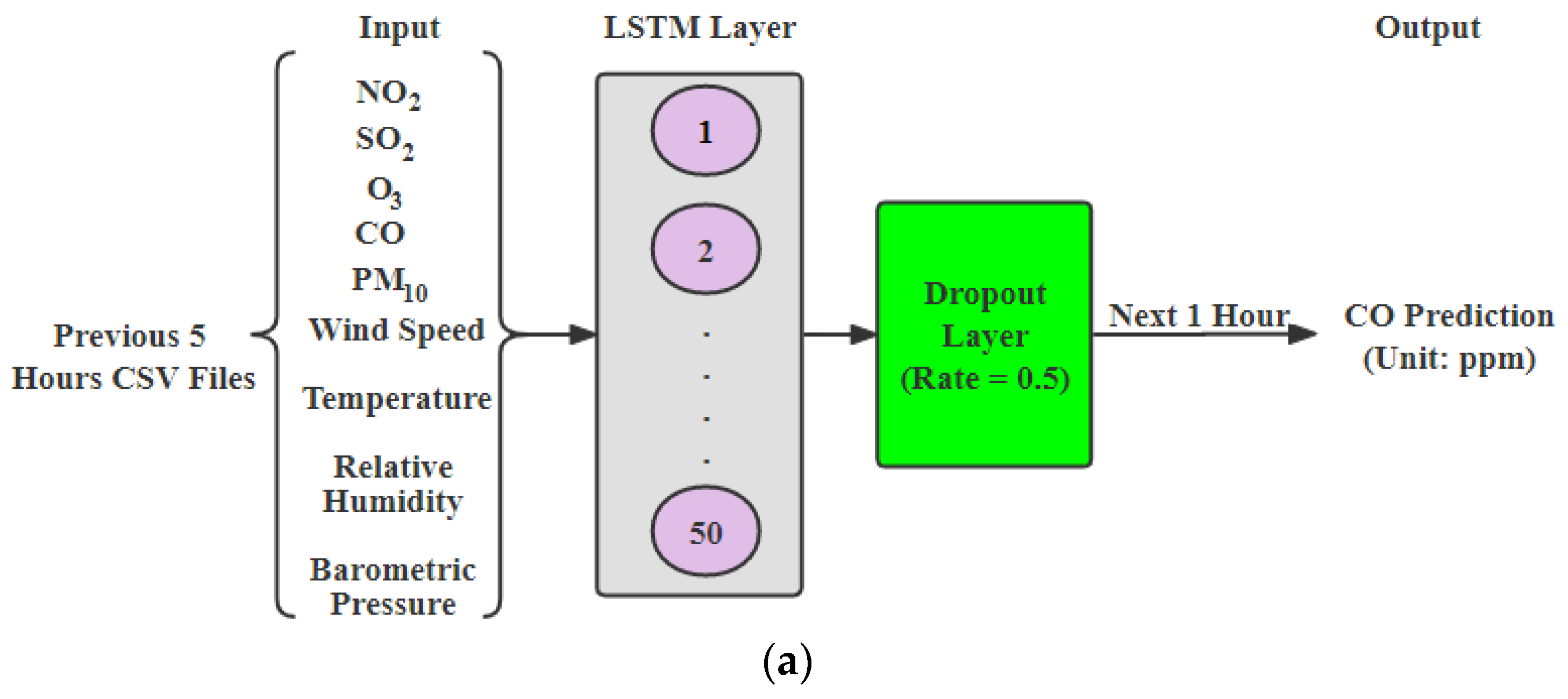
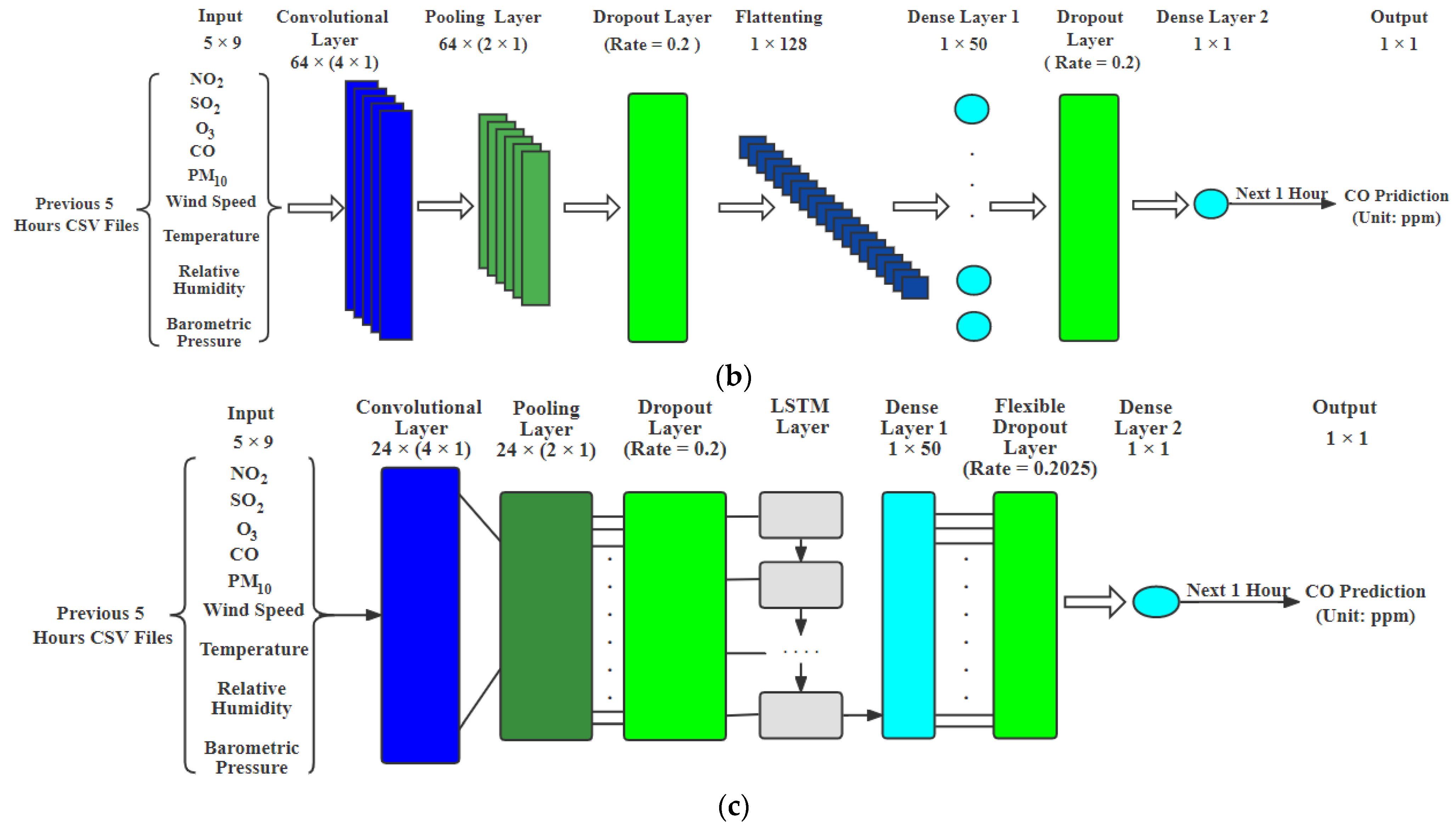
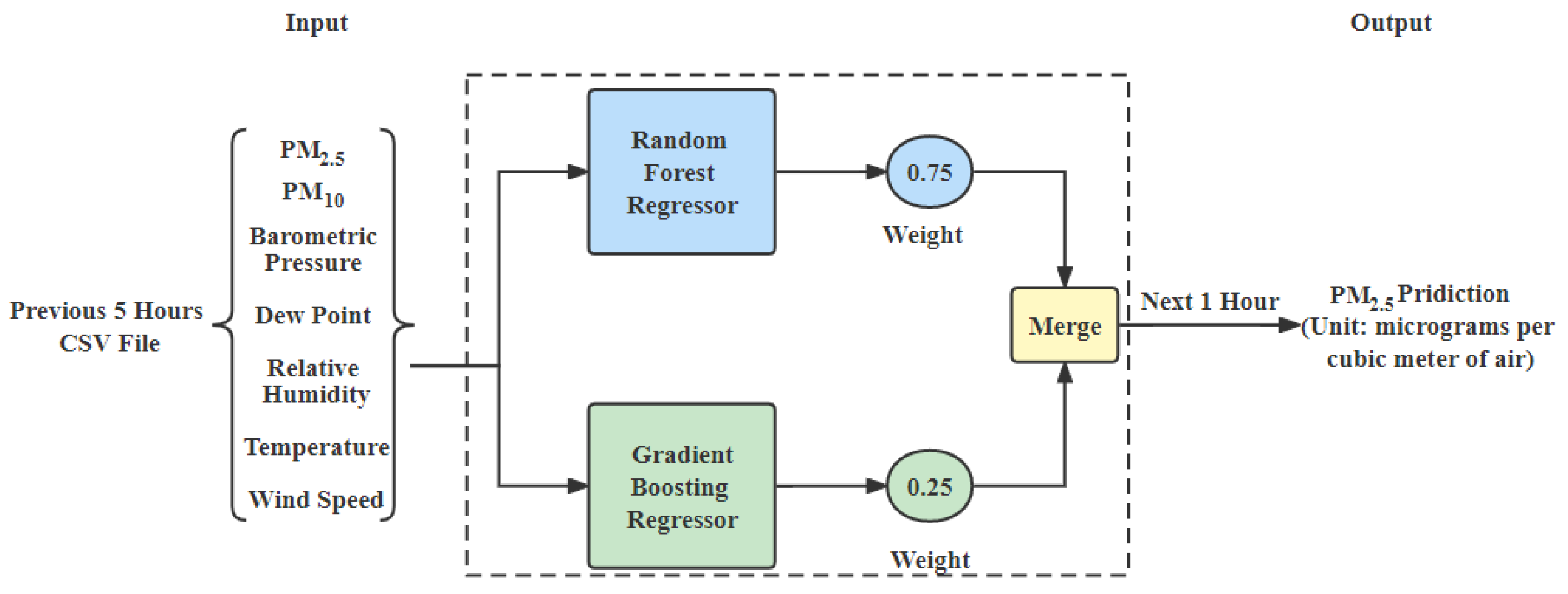
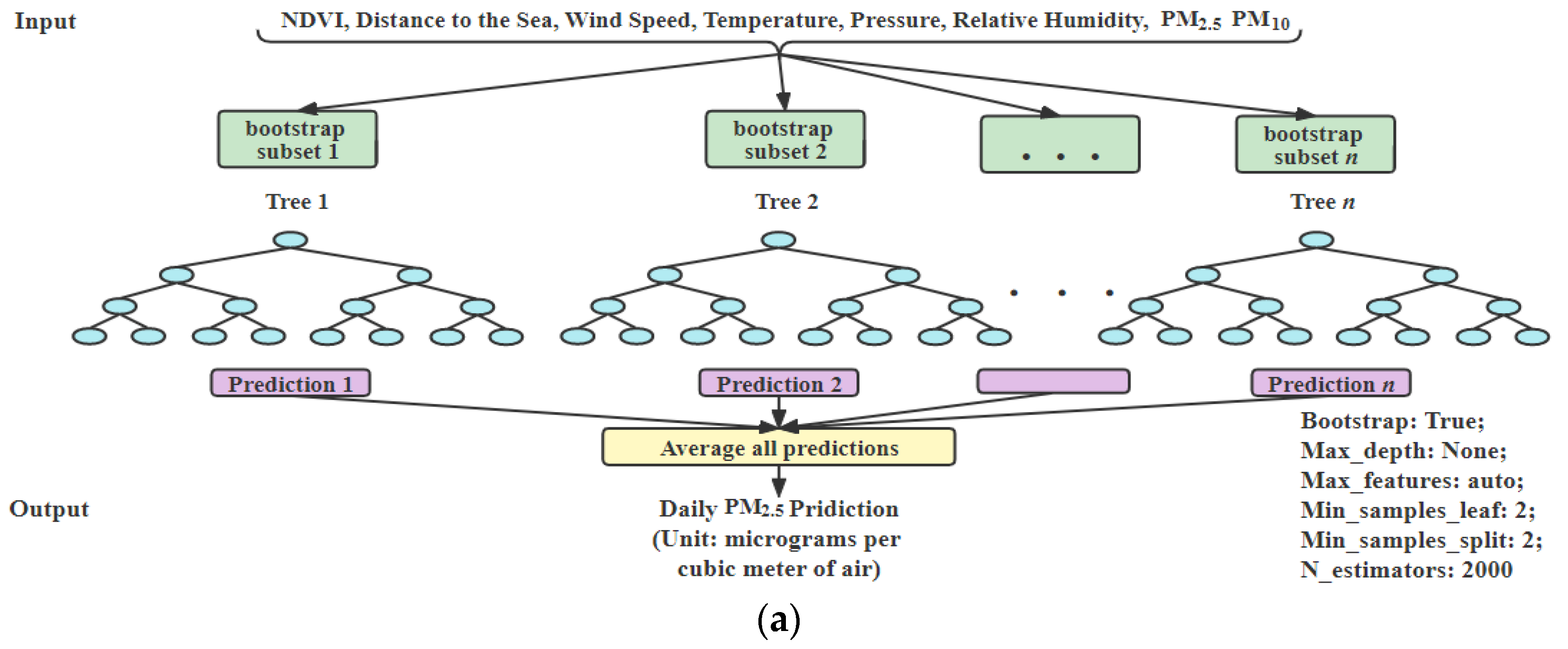
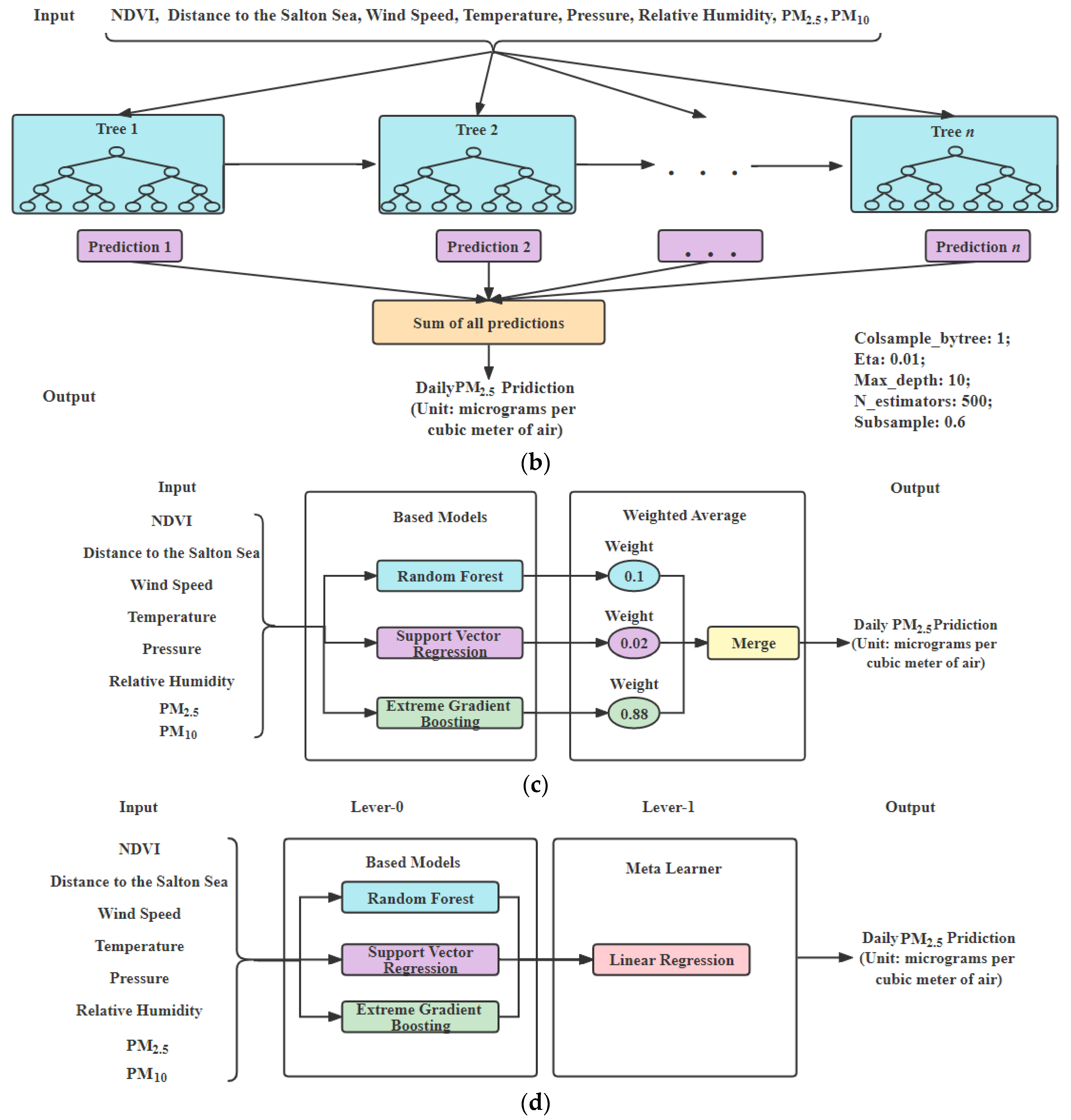
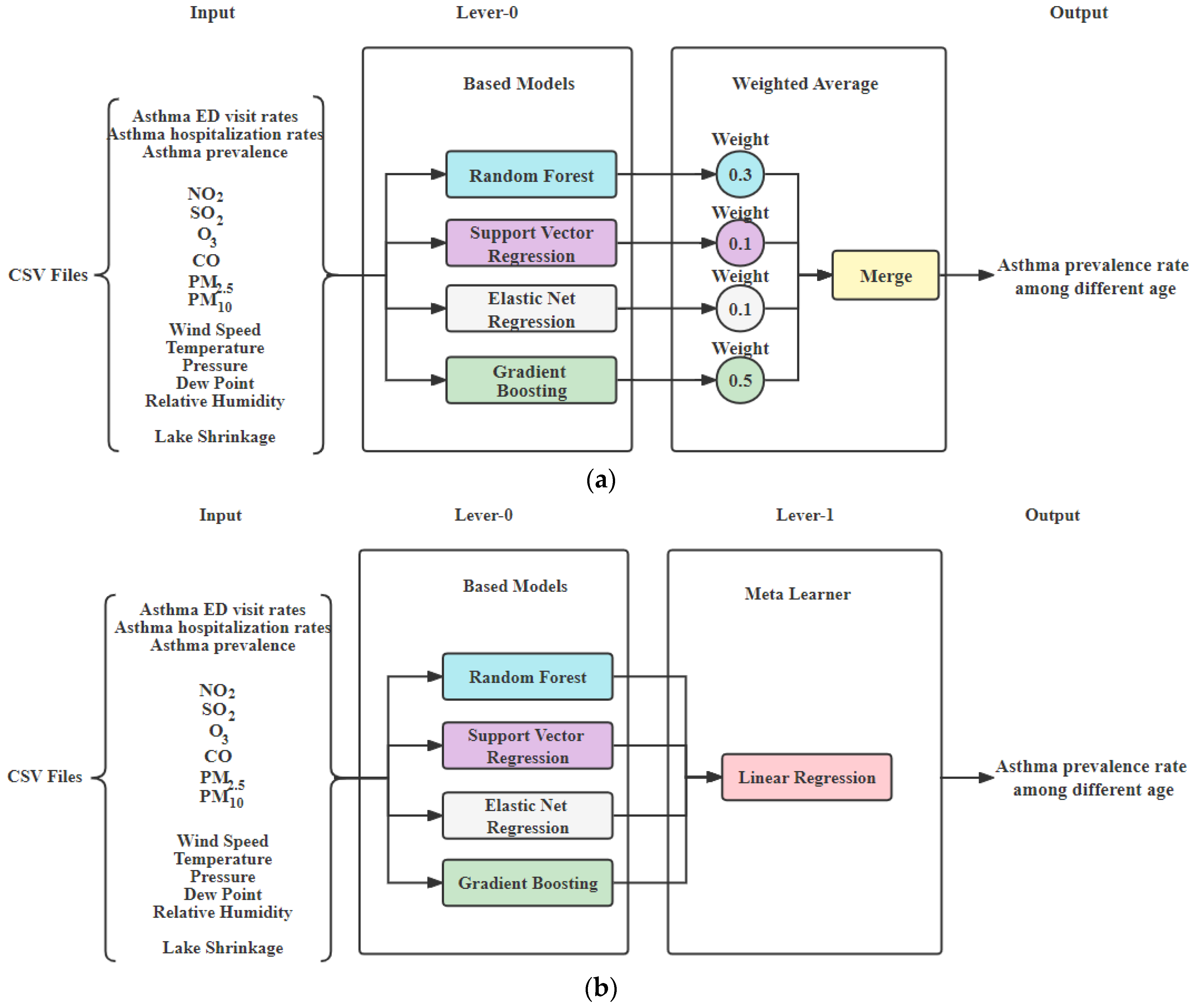
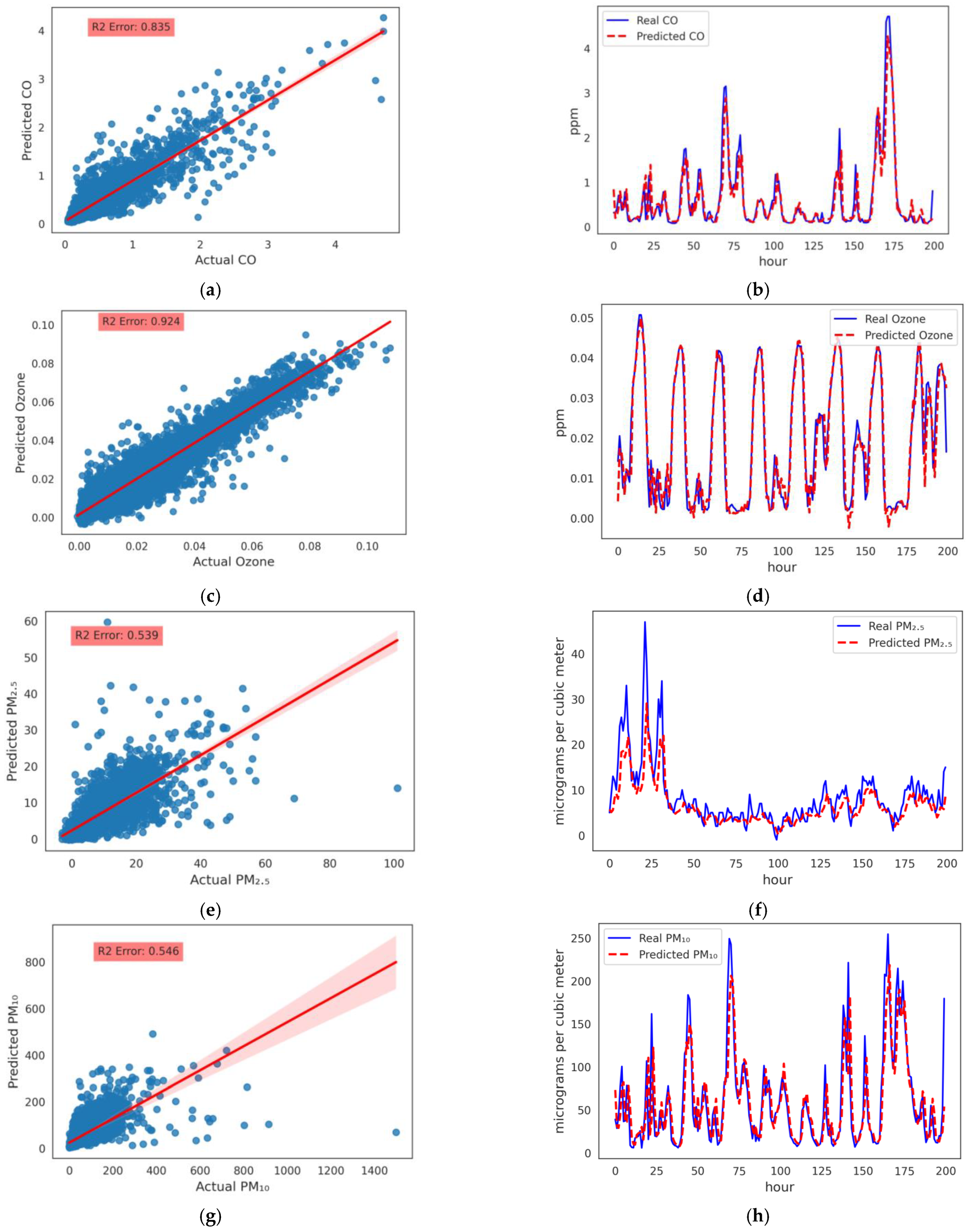

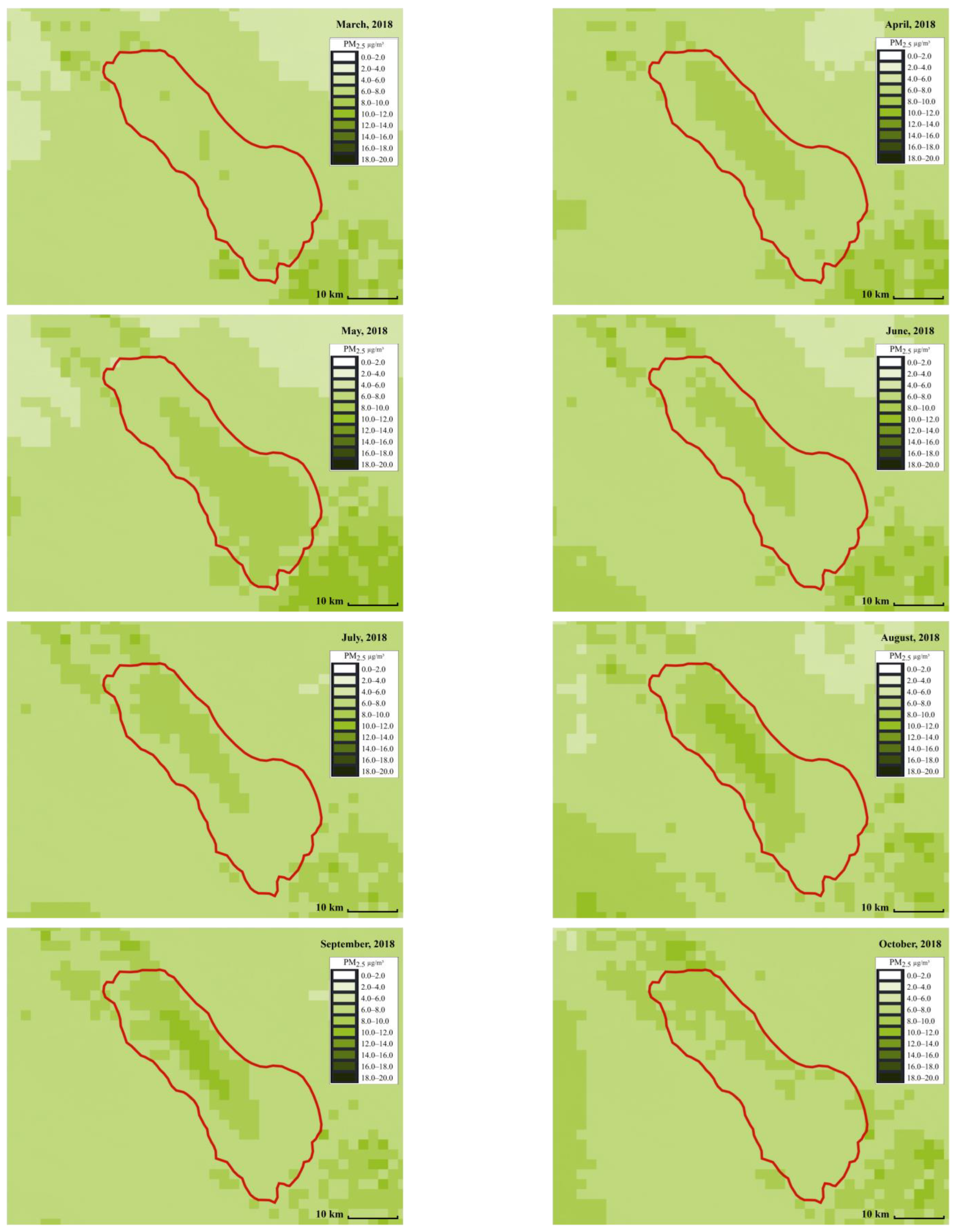

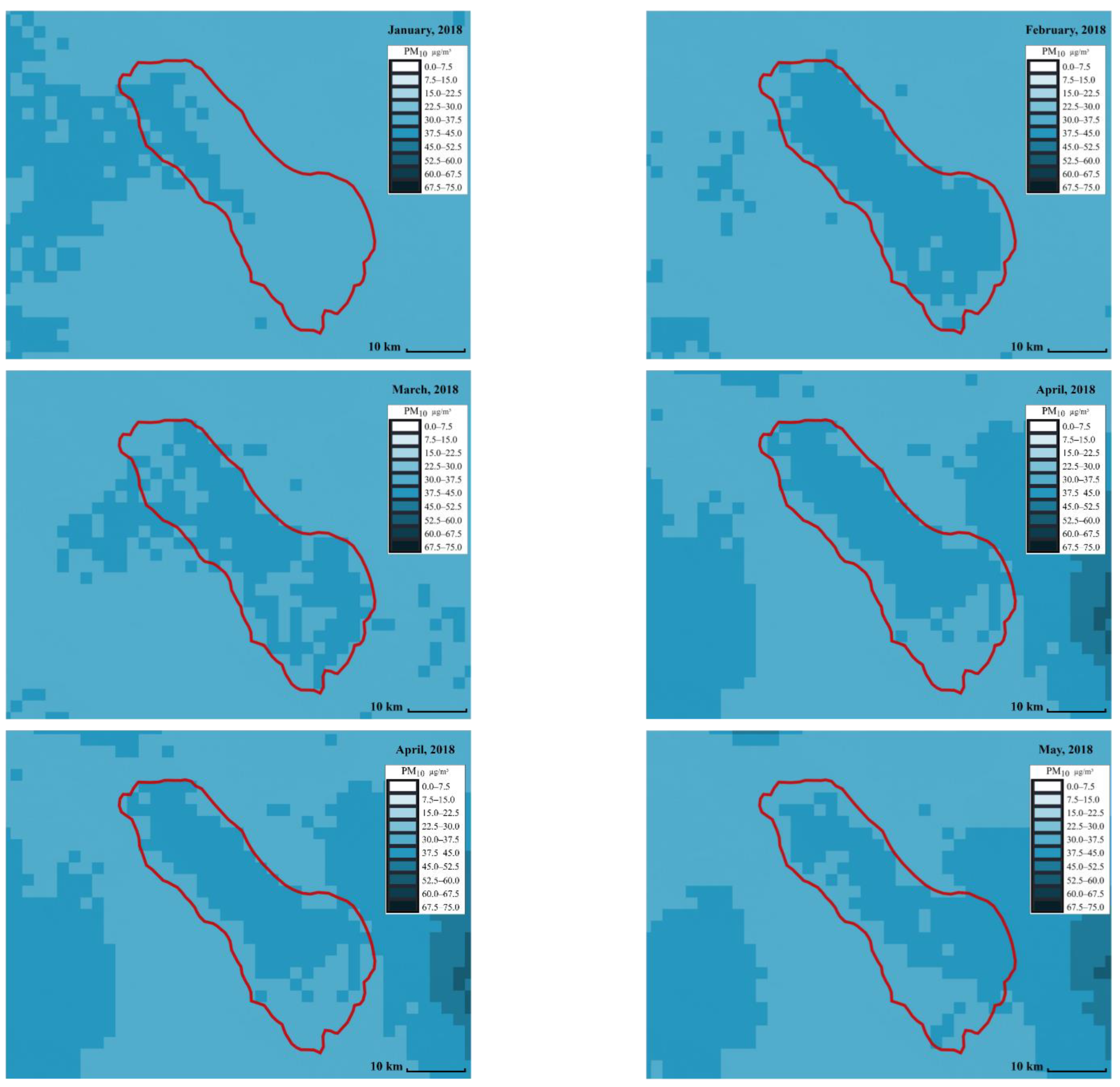
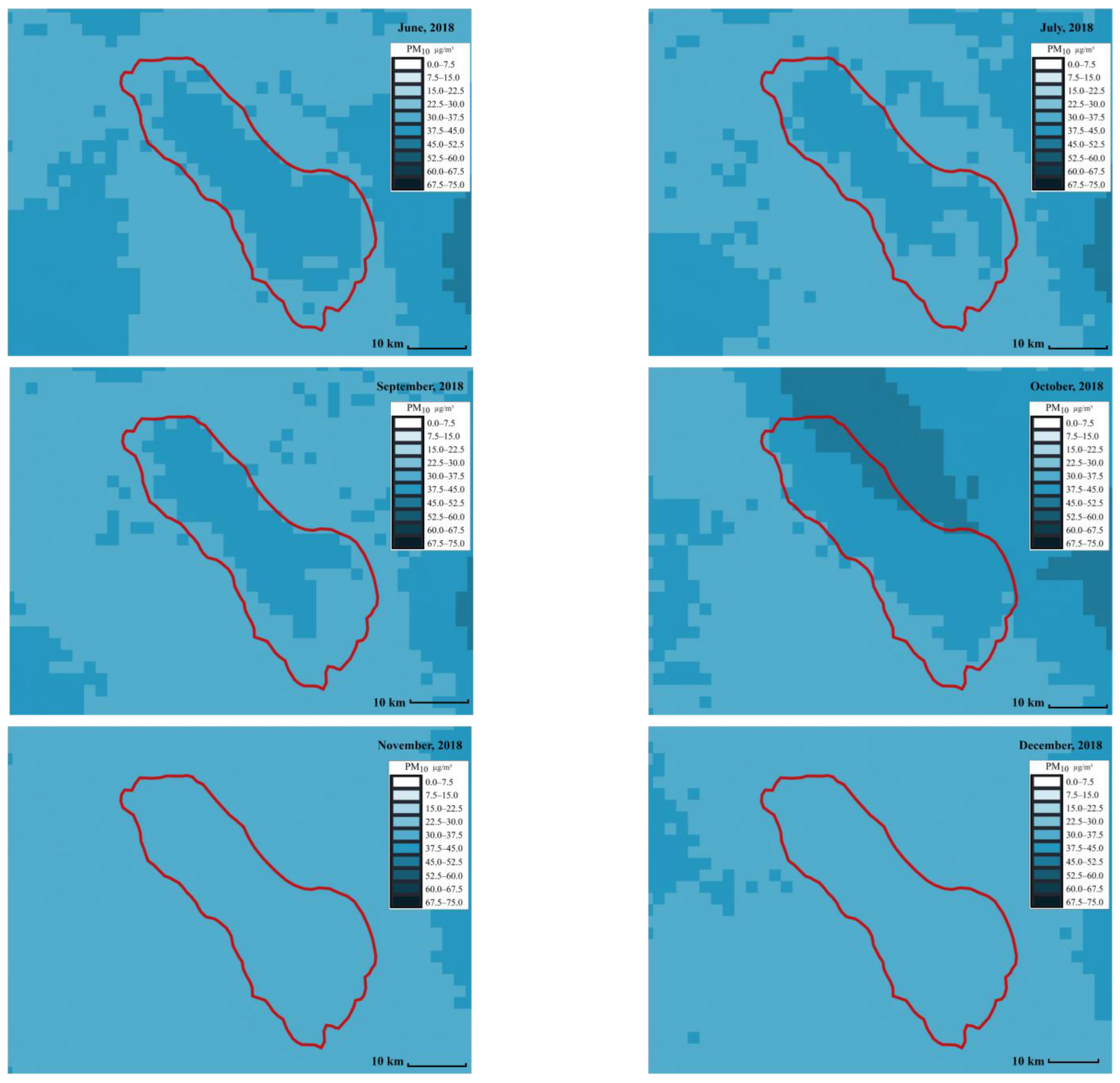
| Reference | Region | Purpose | Model | Accuracy | Input Parameters |
|---|---|---|---|---|---|
| [9] | Tehran, Iran | Predicting and mapping land susceptibility to dust emissions | Cforest | MAE: 3.2% | Soil, topography, climatic variables, vegetation, geology, land use |
| Cubist | MAE: 10.6% | ||||
| Elastic Net | MAE: 10.7% | ||||
| ANFIS | MAE: 11% | ||||
| BMARS | MAE: 11.2% | ||||
| XGBoost | MAE: 11.3% | ||||
| [10] | Ankara, Turkey | Predicting 24-h PM10 | LASSO | RMSE: 25.6 | |
| SVR | RMSE: 25.2 | ||||
| RF | RMSE: 23.5 | ||||
| kNN | RMSE: 23.5 | ||||
| XGBoot | RMSE: 25.0 | ||||
| ANN | RMSE: 20.8 | ||||
| [11] | Jingjinji area, China | Predicting future 1~8-h | LSTM | RMSE: 35.73 | , temperature, wind direction, wind speed, humidity |
| GBDT | RMSE: 59.03 | ||||
| DFNN | RMSE: 44.96 | ||||
| [12] | Malaysia | Predicting air pollutant | MPFF-ANN | RMSE: 10.026 R2: 0.615 | |
| PCA-ANN | RMSE: 10.17 R2: 0.618 | ||||
| [13] | Beijing, China | STDL | RMSE: 14.96 | ||
| STANN | RMSE: 16.19 | ||||
| ARMA | RMSE: 24.40 | ||||
| SVR | RMSE: 22.04 | ||||
| [14] | Cyprus | Forecasting air pollution | LR | R2: 0.8 | , aerosol optical depth, and Synoptic Map Data |
| MLR | R2: 0.83 | ||||
| [15] | Italy | RF | R2: 0.86 | , aerosol optical depth, weather, vegetation index, spatial data | |
| R2 0.84 | |||||
| [16] | Kuantan, Malaysia | Predicting air quality | MLP | RMSE: 8.14 | Air quality, meteorological variables |
| [17] | Quito, Ecuador | MLP | R2: 0.68 | Surface reflectance bands of Landsat-8, NDVI, NDSI, SAVI, NDWI, LST | |
| [18] | Chile | MLP | R2: 0.58 | AOD, meteorological variables | |
| [19] | Alberta, Canada | MLP | R2: 0.61 | AOD, meteorological variables | |
| [20] | Malaysia | MLP | R2: 0.60 | AOD, meteorological and spatial variables | |
| [21] | Tehran, Iran | RF | R2: 0.81 MAE: 9.93 RMSE: 13.58 | Satellite image, meteorological variables | |
| [22] | Shanghai, China | Ensemble Model 1 | MAE: 6.19 MAPE: 0.162 | , meteorological data, season data, timestamp data | |
| [23] | Kuwait | Forecasting ozone | LSTM | MAE < 2 | Hourly air quality, meteorological data |
| [24] | Taiwan | Predicting hourly air quality | CNN | RMSE: 7.37 | and sulfur dioxide |
| [25] | Seoul, South Korea | Predicting ozone | CNN | MAE: 8.90 | , atmospheric pressure, wind speeds and relative humidity |
| [26] | Aksaray, Alibeyköy, Beşiktaş, Esenler, Istanbul | in upcoming hours | DFN | RMSE: 13.67 | density, meteorological data pollution data, traffic data |
| Reference | Region | Purpose | Model | Accuracy | Input Parameters |
|---|---|---|---|---|---|
| [27] | United States | Identifying the impact of pollution on the behavior of people | RF | NRMSE: 0.0798 | , Volatile Organic Compounds |
| LR | NRMSE: 0.2259 | ||||
| SVR | NRMSE: 0.2591 | ||||
| [28] | Tehran, Iran | Studying asthma based on environmental factors along with map locations | RF | Training AUC: 0.987 Testing AUC: 0.921 | , wind speed, rainfall, humidity and temperature |
| [29] | Seoul, South Korea | Predicting the number of asthma patients on a daily level | VAR | MAE: 668.50 | , temperature, humidity, air pressure |
| HDLM | MAE: 479.31 | ||||
| DFNN | MAE: 691.22 | ||||
| LSTM | MAE: 821.72 | ||||
| [30] | California, United States | Showing the correlation between daily air quality and asthma patients | Ridge | RMSE: 0.042 | Daily air quality |
| EN | RMSE: 0.0413 | ||||
| LASSO | RMSE: 0.0412 | ||||
| Gamboost | RMSE: 0.039 | ||||
| DT | RMSE: 0.026 | ||||
| RF | RMSE: 0.71 | ||||
| [31] | Seoul, South Korea | Predicting chances of asthma in children because of inside air pollution | MNL | LSTM outperformed MNL by 57–84% increase in precision | Temperature and particulate matter indoors (for 10 min internal) |
| LSTM |
| Model | Purpose | Advantages | Disadvantages |
|---|---|---|---|
| LSTM [11] | Predicting the future 1~8 h concentration based on the historical records from the past 48 h |
|
|
| ANN [12] | Predicting future air quality by learning from time-series historical data |
|
|
| SVR [13] | Predicting discrete values, which tries to fit the best line (hyperplane) within a threshold value |
|
|
| LR [14] | Predicting PM concentrations for current (d) day by using particulate matter data at (d-1) day |
|
|
| RF [15] | Providing a more accurate prediction by combining predictions from multiple ML algorithms |
|
|
| ARIMA [32] | Predicting a future response value by using the current values, past values, past errors, and past values of other time series |
|
|
| Dataset | Hourly Air Pollutant Forecasting | Particulate Matter Prediction | Health Impact Study | ||||||||
|---|---|---|---|---|---|---|---|---|---|---|---|
| Air Pollutants | Weather | NDVI | Distance to the Salton Sea | Weather | Air Pollutants | Health | Air Quality | Weather | Surface | ||
| Raw Dataset | 334,195 | 568,168 | 201 | 193 | 449,682 | 154,567 | 1431 | 41 | 705 | 985 | |
| Total of Raw Dataset | 902,363 | 604,643 | 3162 | ||||||||
| Pre-Processed Dataset | 52,608 | 17,920 | 1181 | ||||||||
| Transformed Dataset | 52,603 | 17,920 | 64,133 | ||||||||
| Prepared Dataset | Training | 26,265 | 10,752 | 51,233 | |||||||
| Validation | 17,520 | 3584 | NA | ||||||||
| Testing | 8784 | 3584 | 12,933 | ||||||||
| Pollutant | Models | RMSE | MAE | R2 |
|---|---|---|---|---|
| CO | LSTM | 0.151 | 0.075 | 0.835 |
| CNN | 0.175 | 0.106 | 0.779 | |
| DFN | 0.187 | 0.115 | 0.747 | |
| Ozone | LSTM | 0.005 | 0.004 | 0.924 |
| CNN | 0.007 | 0.005 | 0.856 | |
| DFN | 0.008 | 0.006 | 0.839 | |
| PM2.5 | RF | 4.678 | 2.851 | 0.431 |
| GBoost | 4.231 | 2.502 | 0.535 | |
| Ensemble | 4.212 | 2.504 | 0.539 | |
| PM10 | RF | 37.754 | 16.612 | 0.548 |
| GBoost | 38.329 | 16.421 | 0.534 | |
| Ensemble | 37.713 | 16.439 | 0.549 |
| Pollutant | Models | R2 | RMSE | MAE |
|---|---|---|---|---|
| PM2.5 | RF | 0.71 | 3.38 | 2.35 |
| SVR | 0.62 | 3.89 | 2.76 | |
| XGBoost | 0.75 | 3.14 | 2.58 | |
| Weighted average | 0.76 | 3.09 | 2.09 | |
| Stacked ensemble | 0.76 | 2.83 | 2.04 | |
| PM10 | RF | 0.68 | 12.97 | 8.08 |
| SVR | 0.60 | 14.42 | 8.76 | |
| XGBoost | 0.74 | 11.69 | 7.11 | |
| Weighted average | 0.74 | 11.63 | 7.11 | |
| Stacked ensemble | 0.74 | 11.69 | 7.11 |
| Models | Model Set Parameter | R2 | MAE | MSE | RMSE |
|---|---|---|---|---|---|
| RF | Criterion = ‘mse’, max_depth = 50, n_estimators = 100, max_features = 20, random_state = 42. | 0.945 | 0.026 | 0.002 | 0.045 |
| SVR | Kernel = ‘rbf’, gamma = ‘auto’, C = 100, epsilon = 0.01. | 0.897 | 0.038 | 0.003 | 0.062 |
| ENR | Alpha = 0.0001,11_ratio = 0.5, max_iter = 1000, normalize = True. | 0.753 | 0.068 | 0.009 | 0.097 |
| GBoost | max_depth = 50, max_features = 20, min_samples_leaf = 10, min_samples_split = 50, n_estimators = 100, random_state = 42. | 0.949 | 0.024 | 0.001 | 0.043 |
| Weighted Average | Weights for RF, SVR, ENR and GBoost are set to 0.3, 0.1, 0.1, 0.5. | 0.95 | 0.026 | 0.001 | 0.043 |
| Stacked Ensemble | Base learners: RF, SVR, ENR, GBoost. Meta learner: LR. | 0.978 | 0.021 | 0.001 | 0.037 |
| Papers | Region | Purpose | Model | Accuracy | Input Parameters |
|---|---|---|---|---|---|
| [22] | Shanghai, China | Ensemble Model 1 | MAE: 6.19 MAPE: 0.162 | , meteorological data, season data, timestamp data | |
| [23] | Kuwait | Forecasting ozone | LSTM | MAE < 2 | Hourly air quality, meteorological data |
| [24] | Taiwan | Predicting hourly air quality | CNN | RMSE: 7.37 | and sulfur dioxide |
| [25] | Seoul, South Korea | Predicting ozone | CNN | MAE: 8.90 | Ground-level ozone and , atmospheric pressure, wind speeds and relative humidity |
| [26] | Aksaray, AlibeyköyBeşiktaş, Esenler, Istanbul | in upcoming hours | DFN | RMSE: 13.67 | density, meteorological data pollution data, traffic data |
| This work | California, USA | in upcoming hour | LSTM | MAE: 0.004 RMSE: 0.005 R2: 0.924 | Air pollutants, meteorological parameters |
| This work | California, USA | in upcoming hour | LSTM | MAE: 0.075 RMSE: 0.151 R2: 0.835 | Air pollutants, meteorological parameters |
| This work | California, USA | in upcoming hour | Ensemble Model 2 | MAE: 2.504 RMSE: 4.212 R2: 0.539 | , air pressure, dew point, wind speed, humidity, and temperature |
| This work | California, USA | in upcoming hour | Ensemble Model 2 | MAE: 16.439 RMSE: 37.713 R2: 0.549 | and wind speed |
| Original AQI Level | Predicted AQI Level | |
|---|---|---|
| Good | 1719 | 1758 |
| Moderate | 426 | 393 |
| Unhealthy for Sensitive Groups | 9 | 4 |
| Unhealthy | 1 | Not Available |
| Papers | Region | Purpose | Model | Accuracy | Input Parameters |
|---|---|---|---|---|---|
| [17] | Quito, Ecuador | MLP | R2: 0.68 | Surface reflectance bands of Landsat-8, NDVI, NDSI, SAVI, NDWI, LST | |
| [18] | Chile | MLP | R2: 0.58 | AOD, meteorological variables | |
| [19] | Alberta, Canada | MLP | R2: 0.61 | AOD, meteorological variables | |
| [20] | Malaysia | MLP | R2: 0.60 | AOD, meteorological and spatial variables | |
| [21] | Tehran, Iran | RF | R2: 0.81 MAE: 9.93 RMSE: 13.58 | Satellite image, meteorological variables | |
| This work | California, USA | Ensemble Model 3 | MAE: 2.04 RMSE: 2.83 R2: 0.76 | MODIS based NDVI, Landsat 8 based distance to the Salton Sea, weather, air pollutants | |
| This work | California, USA | Ensemble Model 4 | MAE: 7.11 RMSE: 11.63 R2: 0.74 | MODIS based NDVI, Landsat 8 based distance to the Salton Sea, weather, air pollutants |
| Papers | Region | Purpose | Model | Accuracy | Input Parameters |
|---|---|---|---|---|---|
| [27] | United States | Identifying the impact of pollution on the behavior of people | RF | NRMSE: 0.0798 | , Volatile Organic Compounds |
| LR | NRMSE: 0.2259 | ||||
| SVR | NRMSE: 0.2591 | ||||
| [28] | Tehran, Iran | Studying asthma based on environmental factors along with map locations | RF | Training AUC: 0.987 Testing AUC: 0.921 | , wind speed, rainfall, humidity and temperature |
| [29] | Seoul, South Korea | Predicting the number of asthma patients at daily level | VAR | MAE: 668.50 | , humidity, temperature, air pressure |
| HDLM | MAE: 479.31 | ||||
| DFNN | MAE: 691.22 | ||||
| LSTM | MAE: 821.72 | ||||
| [30] | California, United States | Showing the correlation between daily air quality and asthma patients | Ridge | RMSE: 0.042 | Daily air quality |
| EN | RMSE: 0.0413 | ||||
| LASSO | RMSE: 0.0412 | ||||
| Gamboost | RMSE: 0.039 | ||||
| DT | RMSE: 0.026 | ||||
| RF | RMSE: 0.71 | ||||
| [31] | Seoul, South Korea | Predicting chances of asthma on children because of inside air pollution | MNL | LSTM outperformed MNL by 57–84% increase in precision | Temperature and particulate matter for indoors (for 10 min internal) |
| LSTM | |||||
| This work | California, United States | Predicting the asthma prevalence rate | Ensemble Model 5 | MAE: 0.021 MSE: 0.001 RMSE: 0.037 R2: 0.976 | , wind speed, pressure, dew point, temperature, relative humidity, healthy data |
Publisher’s Note: MDPI stays neutral with regard to jurisdictional claims in published maps and institutional affiliations. |
© 2022 by the authors. Licensee MDPI, Basel, Switzerland. This article is an open access article distributed under the terms and conditions of the Creative Commons Attribution (CC BY) license (https://creativecommons.org/licenses/by/4.0/).
Share and Cite
Gao, J.; Liu, J.; Xu, R.; Pandey, S.; Vankayala Siva, V.S.K.S.; Yu, D. Environmental Pollution Analysis and Impact Study—A Case Study for the Salton Sea in California. Atmosphere 2022, 13, 914. https://doi.org/10.3390/atmos13060914
Gao J, Liu J, Xu R, Pandey S, Vankayala Siva VSKS, Yu D. Environmental Pollution Analysis and Impact Study—A Case Study for the Salton Sea in California. Atmosphere. 2022; 13(6):914. https://doi.org/10.3390/atmos13060914
Chicago/Turabian StyleGao, Jerry, Jia Liu, Rui Xu, Samiksha Pandey, Venkata Sai Kusuma Sindhoora Vankayala Siva, and Dian Yu. 2022. "Environmental Pollution Analysis and Impact Study—A Case Study for the Salton Sea in California" Atmosphere 13, no. 6: 914. https://doi.org/10.3390/atmos13060914
APA StyleGao, J., Liu, J., Xu, R., Pandey, S., Vankayala Siva, V. S. K. S., & Yu, D. (2022). Environmental Pollution Analysis and Impact Study—A Case Study for the Salton Sea in California. Atmosphere, 13(6), 914. https://doi.org/10.3390/atmos13060914








